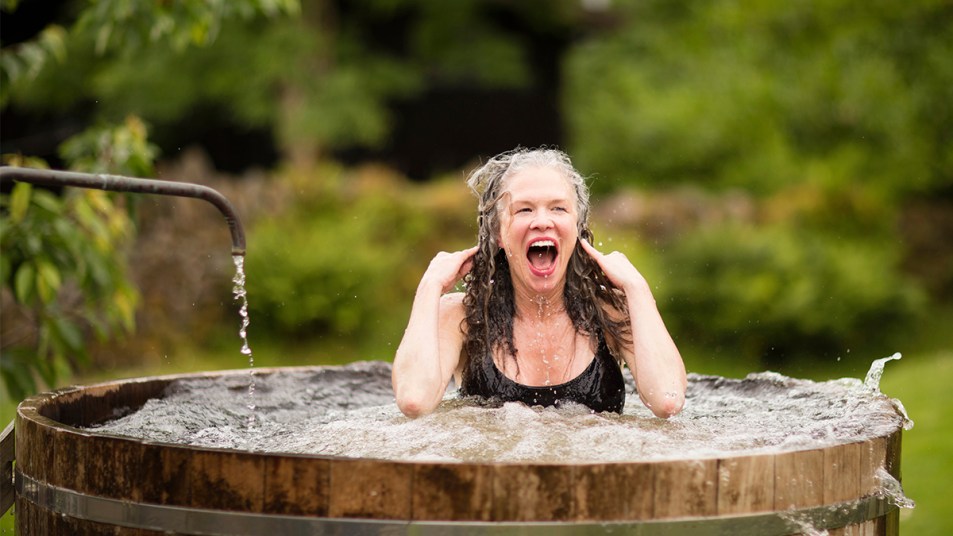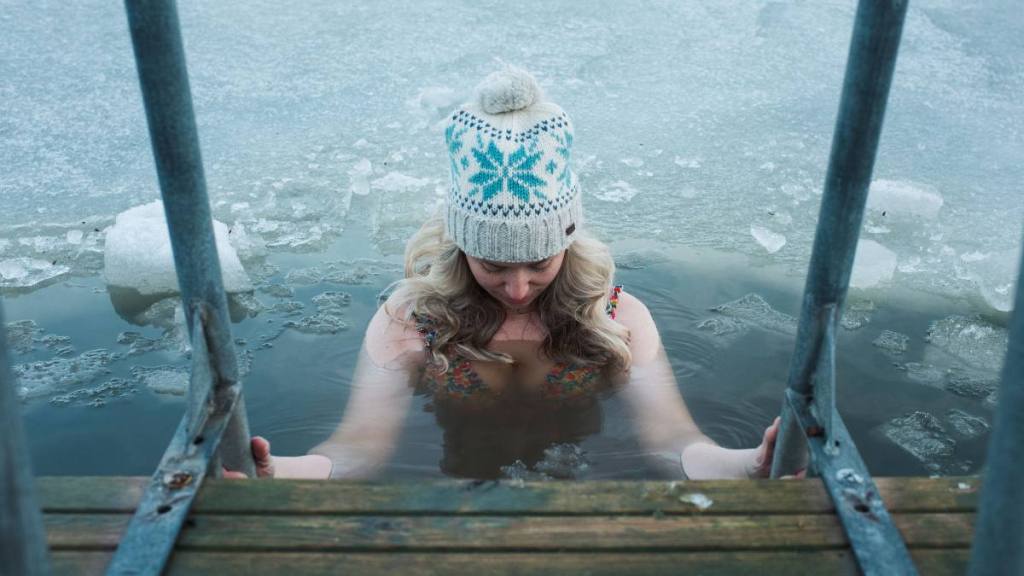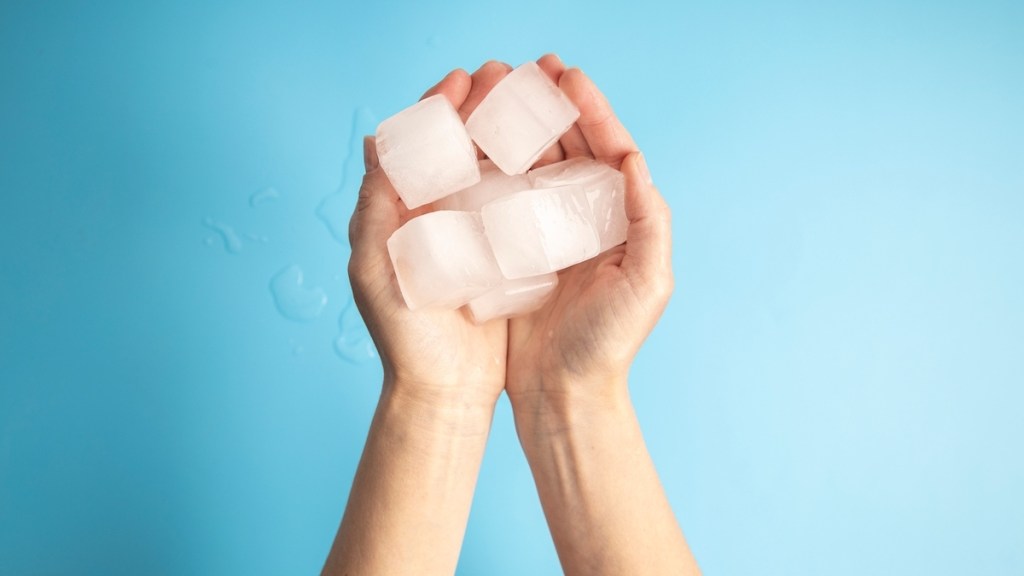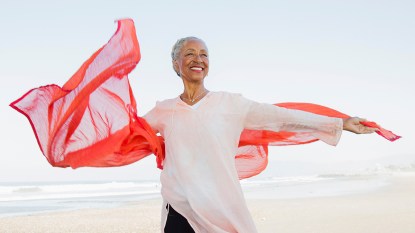Study: A Cold Plunge Eases Hot Flashes, Mood Swings + More Menopause Symptoms — How to Get the Perks
And how to benefit if you don't have a cold plunge pool

These days it seems everyone is diving into the cold plunge trend, soaking in ice-cold water to reduce post-workout soreness, boost immunity, rev energy and more. But we’re most intrigued by the latest research from the University College of London, suggesting that a cold plunge can relieve menopause discomforts like hot flashes and mood swings. After investigating the benefits of a cold plunge for menopause, the team concluded that cold water swimming (and cold plunges, in general) provided a positive overall effect on perimenopausal and menopausal symptoms (details below). To learn more about cold water’s powerful healing effects, we connected with several women’s health experts and an exercise physiologist.
How a cold plunge eases menopause symptoms
The study was published in Sage Journals and featured 1,114 women who regularly swam outdoors in unheated water. Of those participants, 785 were going through menopause.
Each participant was asked to complete a 42-question survey about their open-water swimming habits and their menstrual or menopausal symptoms. After compiling and analyzing participant responses, the researchers concluded that cold water swimming (aka cold plunges) reduced anxiety, mood swings, irritability and hot flashes. Similarly, nearly 60% of the participants said they did cold plunges regularly to relieve menstrual and/or menopausal symptoms.
Those results are impressive alright, but what is it about cold water that makes it so good at relieving menstrual and menopausal discomforts? Dawn Ericsson, MD, a board-certified, Yale-trained obstetrician-gynecologist, says several factors are at play:
A cold plunge calms hot flashes
“Cold temperatures stimulate many blood vessels to constrict, slowing blood flow to less vital areas and increasing circulation to the brain, heart and lungs,” she explains. Since many menopausal symptoms, including hot flashes, night sweats and heart palpitations, are caused by the constriction and dilation of blood vessels, it makes sense that cold plunges provide some relief.
Related: The 9 Best Foods That Fight Hot Flashes, According to MDs — No Medication Required
A cold plunge fights brain fog
Cold water exposure triggers the release of stress hormones, like adrenaline. Dr. Ericsson says that adrenaline improves mental alertness. That’s a boon for women who suffer menopausal brain fog. Sarah Bonza, MD, MPh, a perimenopause and menopause specialist, echoes these sentiments, adding that cold water swimming also boosts the release of endorphins, which are natural pain relievers in the body.
Related: It’s Not Your Imagination: Menopause Brain Fog *Is* Real — MDs Reveal How to Sharpen Your Thinking
Other benefits of a cold plunge

A cold plunge boosts immunity
The hormone fluctuations caused by menopause often increase inflammation throughout the body. Here too, cold plunges make a difference. “The immune system largely regulates inflammation,” says Matthew Accetta, MS, ACSM-CEP, CSCS*D, CSPS, an exercise physiologist at the Hospital for Special Surgery (HSS). “Swimming in cold water has been shown to reduce inflammation in the joints and muscle soreness. Some studies have also shown that cold water swimming, plunges, and showers increase white blood cell counts which are responsible for fighting infection.”
Indeed, a study conducted by researchers in the Netherlands found that people who took cold showers daily were 29% less likely to call out sick from work compared to participants who didn’t take cold showers. Another study, published in the journal Biochemia Medica, concluded that cold water swimming increased red blood cell, white blood cell, and platelet counts significantly.
A cold plunge eases stress
Cold plunges may even be a boon for your mental health! Alyssa Dweck, MS, MD, FACOG, a certified gynecologist and the Chief Medical Officer at Bonafide Health, says the “companionship and community afforded by cold plunge events can minimize stress.” Likewise, she says being outside can optimize your mood and help you feel your best.
Related: Chronic Stress? Experts Say These Delicious Cortisol-Lowering Foods Can Help
Who should consider a cold plunge for menopause?
Consider trying a cold plunge if you have any of the following symptoms:
- Hot flashes
- Mood swings
- Anxiety
- Night sweats
- Dry skin
- Difficulty sleeping
That said, don’t go cold water swimming until you get the all clear from your doctor. “Cold plunges are NOT for everyone,” Dr. Bonza says. The ideal temperature is below 59 degrees Fahrenheit, and Dr. Bonza warns, “Extremes of temperature, specifically cold temperatures, may be harmful to people with heart disease, high blood pressure, respiratory issues and/or thermoregulation issues. I advise cautiousness, safety, moderation and a physician consultation before making cold plunges part of your routine.”
Even if you don’t have any underlying health problems, it’s crucial you talk with your doctor. Cold plunges are safe for most people, but you must get clearance first. (Click through to learn how seed cycling can ease menopause symptoms, too.)
What to wear to cold plunge
Doing a cold plunge requires more clothing than a typical bathing suit, especially if you’re a beginner. “Newcomers should start with some level of basic clothing to protect areas of the body that are more sensitive to cold and at risk for frostbite,” Dr. Ericsson says. “The most concerning areas are the hands, feet, head and genital area because heat loss can be more rapid there.”
Specifically, Dr. Ericsson recommends wearing a long sleeve shirt, shorts, waterproof shoes and waterproof gloves. “These garments allow newbies to build tolerance to the chilly water and eventually withstand longer submersion times,” she adds.
Do you need a cold plunge tub?
Cold plunges can be done in almost any body of cold water, but if you don’t live near the ocean, a lake, or a river, a cold plunge tub is worth considering. Check out our guide to the best cold plunge tubs. “The cost for a cold plunge tub ranges from $60 to $125 on the low end and $1,000 or greater on the high end,” Dr. Ericsson says. “Of course, you can benefit from cold water immersion without the expense.”
3 cold plunge alternatives
It’s true! There are several alternatives to cold plunge tubs, including:
Ice bath
If your bathtub is long enough and deep enough to submerge your entire body, try filling it with ice water. “This is a cheap alternative, Accetta says. “But it might take longer for the water to reach the ideal temperature of between 39 to 50 degrees Fahrenheit.”
Cold shower
No bathtub? No problem! Try rinsing off in a cold shower. “Cold showers have shown some effectiveness at eliciting the same response,” Accetta says. “[However,] It’s not as effective as a cold plunge, because it’s hard to immerse the whole body at once while standing in the shower.”
Ice cubes

“Even rubbing an ice cube on your face can help ground you when you’re feeling stressed,” Dr. Dr. Bonza says. “It doesn’t have to be immersive, as the idea here is to expose yourself to the sensation of coldness.”
Dr. Bonza knows what she’s talking about! A study published in the journal Aerospace Medicine and Human Performance found that even mild cold exposure caused shifts in the parasympathetic nervous system, which plays a crucial role in how the body responds to stress and anxiety.
Related: 17 Brilliant Uses for Ice Cubes (Besides Keeping Your Drinks Cold)
How often to do a cold plunge for menopause
Some women experience near-instant relief from menopause symptoms after their first cold plunge. But results like these are more an exception than a rule. You see, the effects of cold plunge therapy are cumulative. In other words, repeated cold exposure is essential for the best results.
Accetta says he encourages beginners to start slowly, cold plunging no more than 1 to 2 times per week. “This allows your body to recover and adjust to treatment in between sessions,” he explains. “Once you feel ready, you can progress to 2 to 3 times a week.”
Adds Dr. Ericsson: “The frequency of your cold immersion sessions should match up with your physical condition, [your] response to cold exposure, and your goals.”
The bottom line
“As a menopause specialist, I’d say that cold plunges show interesting promise on being an adjunct therapy for dealing with menopause and perimenopause symptoms, such as hot flashes,” Dr. Bonza says. “The key to a nice start is doing a cold plunge slowly and listening to whatever your body is telling you.”
And when you’re done, consider warming up under a weight blanket! Click through to learn more about the benefits of weighted blankets.
For more on menopause, click through the links below!
Sweet Potatoes Help Tame Menopausal Hot Flashes, Mood Swings & Vaginal Dryness
“Perimenopause Made Me Foggy and Tired — Until I Found This Natural Cure!”
This content is not a substitute for professional medical advice or diagnosis. Always consult your physician before pursuing any treatment plan.













